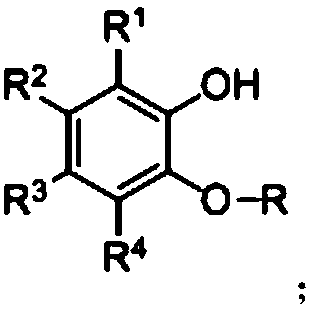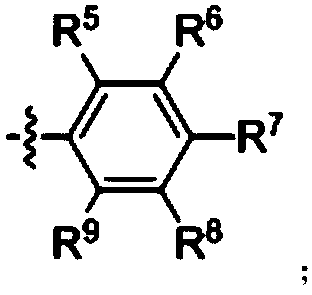A kind of ether bond breaking method of o-hydroxyphenyl alkyl ether
A technology of o-hydroxyphenyl alkyl ether and hydroxyphenyl alkyl ether, which is applied in the field of intermediate synthesis of medicines and chemical raw materials, can solve the problems of affecting yield, low yield of eugenol demethylation reaction, etc. Wide application range and high catalytic activity
- Summary
- Abstract
- Description
- Claims
- Application Information
AI Technical Summary
Problems solved by technology
Method used
Image
Examples
Embodiment 1
[0030] Example 1 (demethylation of eugenol)
[0031]
[0032] Iodine (12.727g), aluminum powder (1.902g) and acetonitrile (100ml) were respectively added to a 250ml eggplant-shaped flask, heated to reflux, and stirred for 2 hours until the purple-red color of iodine disappeared. Pyridine (12.183 g) and eugenol (4.919 g) were further added, and the reaction was continued for 18 hours. The stirring was stopped, and after cooling to room temperature, 2 mol / L dilute hydrochloric acid (50 ml) was added to the reaction solution for acidification, and the mixture was extracted with ethyl acetate (50 ml×4). The organic phases were combined and dried over anhydrous sodium sulfate. Filtration, the filtrate was evaporated to dryness with a rotary evaporator, and the residue was purified by flash column chromatography (mobile phase: ethyl acetate: petroleum ether=1:4, volume ratio) to obtain 4-allylcatechol (white solid) , 4.910 g, 99% yield).
[0033] 1H NMR(400MHz, CDCl3)δ6.80(d,J...
Embodiment 2
[0035] Example 2 (demethylation of eugenol)
[0036]
[0037] Iodine (2.098g), aluminum powder (0.362g) and acetonitrile (50ml) were respectively added to a 100ml eggplant-shaped flask, heated to reflux, and stirred for 2 hours until the purple-red color of iodine disappeared. Further DMAP (2.750 g) and eugenol (0.825 g) were added and the reaction continued for 18 hours. The stirring was stopped, and after cooling to room temperature, 2 mol / L dilute hydrochloric acid (10 ml) was added to the reaction solution for acidification, and the mixture was extracted with ethyl acetate (50 ml×3). The organic phases were combined and dried over anhydrous sodium sulfate. Filtration, the filtrate was evaporated to dryness with a rotary evaporator, and the residue was purified by flash column chromatography (mobile phase: ethyl acetate: petroleum ether=1:4, volume ratio) to obtain 4-allylcatechol (white solid) , 0.362 g, 48% yield), and recovered starting material (0.202 g).
Embodiment 3
[0038] Example 3 (demethylation of eugenol)
[0039]
[0040]Add iodine (2.107g), aluminum powder (0.409g) and acetonitrile (50ml) respectively to a 100ml eggplant-shaped bottle, heat to reflux, and stir for 2 hours until the purple color of iodine disappears. Further 2,6-lutidine (2.750 g) and eugenol (0.823 g) were added, and the reaction was continued for 18 hours. Stop stirring, cool to room temperature, add 2mol / L dilute hydrochloric acid (10ml) to the reaction solution to acidify, and extract with ethyl acetate (50ml×3). The organic phases were combined and dried over anhydrous sodium sulfate. Filtration, the filtrate was evaporated to dryness with a rotary evaporator, and the residue was purified by flash column chromatography (mobile phase was ethyl acetate:petroleum ether=1:4, volume ratio) to obtain 4-allyl catechol (white solid , 0.692g, yield 92%).
PUM
 Login to View More
Login to View More Abstract
Description
Claims
Application Information
 Login to View More
Login to View More - R&D
- Intellectual Property
- Life Sciences
- Materials
- Tech Scout
- Unparalleled Data Quality
- Higher Quality Content
- 60% Fewer Hallucinations
Browse by: Latest US Patents, China's latest patents, Technical Efficacy Thesaurus, Application Domain, Technology Topic, Popular Technical Reports.
© 2025 PatSnap. All rights reserved.Legal|Privacy policy|Modern Slavery Act Transparency Statement|Sitemap|About US| Contact US: help@patsnap.com



